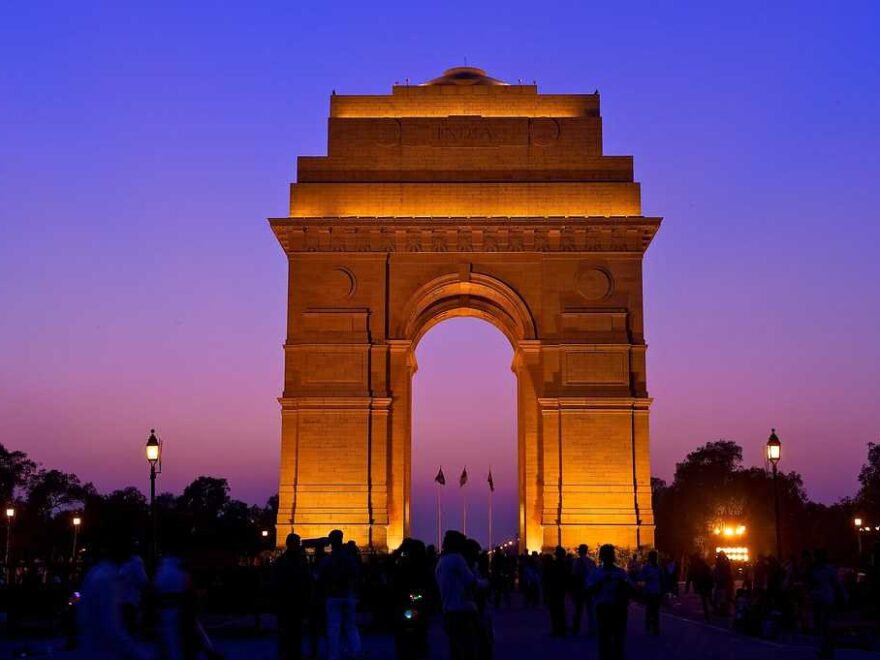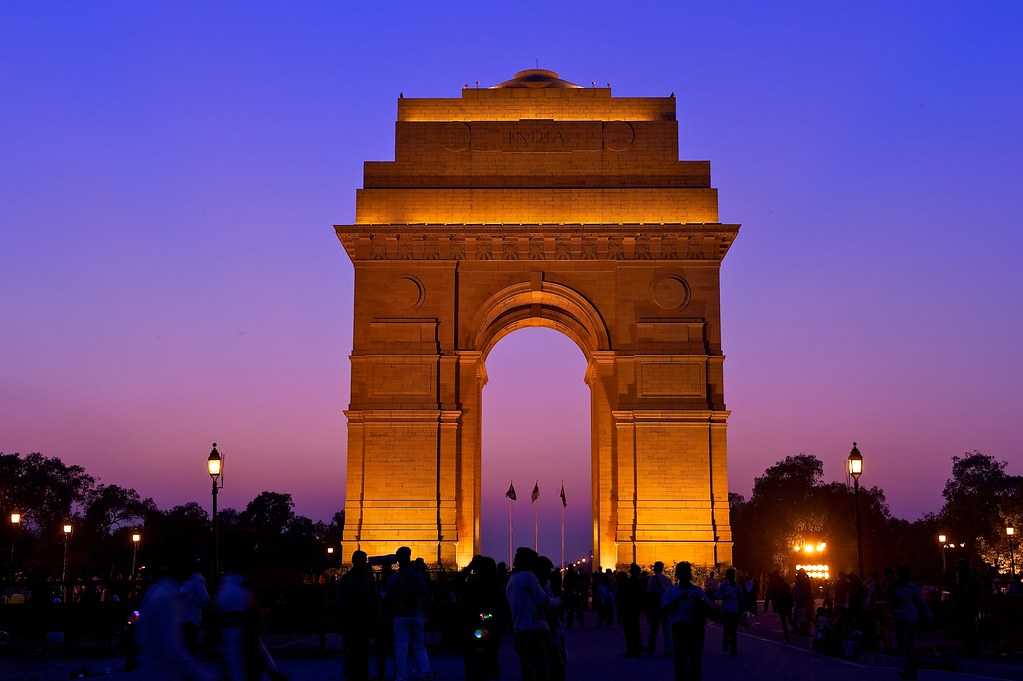
India Gate:
India Gate stands tall and resolute in the heart of New Delhi, a testament to the nation’s rich history and the sacrifices made by its brave soldiers. This iconic monument holds a special place in the hearts of millions, symbolizing unity, valor, and the indomitable spirit of the Indian people.
Historical Significance:
Built in 1931, India Gate was originally known as the All India War Memorial. Its primary purpose was to honor the 70,000 Indian soldiers who lost their lives fighting for the British Indian Army during World War I. The monument’s architecture, inspired by the Arc de Triomphe in Paris, reflects a fusion of Indian and British design elements.
Architectural Splendor:
Designed by Sir Edwin Lutyens, India Gate is a magnificent structure crafted from red sandstone. The arch stands at an impressive height of 42 meters and bears the names of soldiers inscribed on its walls. The Amar Jawan Jyoti, an eternal flame, was added later beneath the arch to commemorate the Unknown Soldier, symbolizing the sacrifice of all Indian soldiers who laid down their lives in subsequent wars.
Gathering Place for Unity:
Beyond its historical significance, India Gate serves as a popular gathering place for locals and tourists alike. The lush lawns surrounding the monument offer a peaceful retreat, attracting families, friends, and joggers. The evenings see the monument illuminated, creating a picturesque setting for leisurely strolls and picnics.
Honoring the Martyrs:
Every year on Republic Day, the President of India pays homage to the fallen soldiers by laying a wreath at the Amar Jawan Jyoti. This solemn ceremony is a reminder of the sacrifices made to secure the nation’s freedom and protect its values.
Cultural Hub:
Surrounded by important government buildings and iconic landmarks, India Gate is a central point for various cultural events and celebrations. It has witnessed countless gatherings, from political rallies to cultural festivals, making it a dynamic space that echoes with the vibrancy of Indian life.
Challenges and Preservation:
While India Gate stands as a symbol of pride and heritage, it faces challenges such as pollution and urbanization. Efforts are underway to preserve and protect this national treasure, ensuring that future generations can continue to connect with India’s rich past.
In conclusion,
India Gate is not merely a monument; it is a living testament to the courage and sacrifice of those who fought for the nation. It stands as a beacon of unity, inviting people from all walks of life to reflect on India’s journey and envision a future shaped by resilience, diversity, and unwavering patriotism.
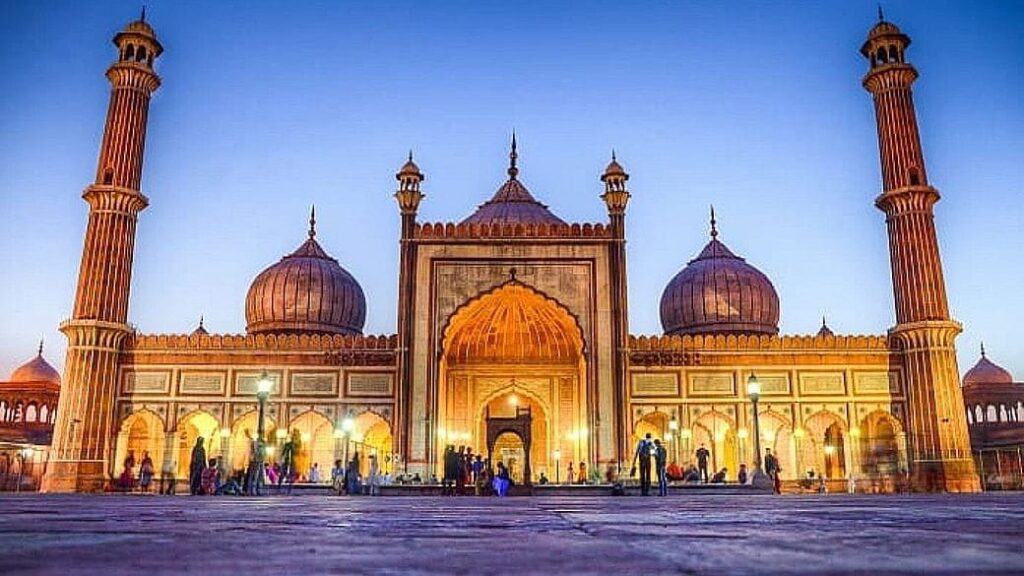
Jama Masjid Delhi’s
Jama Masjid, located in the heart of Old Delhi, stands as a testament to the grandeur of Mughal architecture and the rich cultural heritage of India. Built by the fifth Mughal Emperor, Shah Jahan, this magnificent mosque is one of the largest in the country, offering a glimpse into the historical and religious tapestry of the region.
Historical Significance:
Constructed between 1650 and 1656, Jama Masjid is an architectural marvel that reflects the opulence of the Mughal era. The name “Jama Masjid” translates to “Friday Mosque,” emphasizing its importance as a place of congregational worship for the Muslim community. The mosque was designed by the renowned architect Ustad Khalil and is a harmonious blend of Persian, Timurid, and Indian architectural styles.
Architectural Grandeur:
The mosque is built with red sandstone and white marble, creating a striking visual contrast that adds to its allure. Three grand entrances, four towering minarets, and a vast courtyard capable of accommodating thousands of worshippers contribute to the mosque’s imposing presence. The central dome, adorned with intricate calligraphy and delicate motifs, adds to the mosque’s aesthetic appeal.
Courtyard and Minarets:
The courtyard, enclosed by high arched cloisters, is a sprawling expanse where worshippers gather for prayers, especially during the holy month of Ramadan. The three imposing gates—named after prominent city gates—lead to the courtyard and are symbolic entrances for devotees. The minarets, standing at a height of 40 meters, offer panoramic views of Old Delhi, providing a historical perspective of the city.
Religious Significance:
Jama Masjid holds religious importance as it is a place where the devout come together for congregational prayers, particularly on Fridays. The mosque’s serenity and spiritual ambiance make it a revered space for Muslims, attracting visitors from across the globe who seek to experience the cultural and religious richness it embodies.
Cultural Hub:
Beyond its religious significance, Jama Masjid has become a cultural hub, attracting tourists and historians eager to explore its architectural splendor and understand its historical context. The bustling markets surrounding the mosque offer a sensory overload of sights, sounds, and flavors, making it a must-visit destination for anyone exploring Delhi’s vibrant heritage.
Preservation and Restoration:
Over the centuries, Jama Masjid has withstood the test of time and witnessed the ebb and flow of Delhi’s history. The Archaeological Survey of India (ASI) plays a crucial role in preserving and maintaining this architectural gem, ensuring that future generations can continue to marvel at its beauty and appreciate its historical significance.
In conclusion,
Jama Masjid stands as a timeless symbol of Delhi’s cultural and religious diversity. Its architectural brilliance, historical significance, and role as a spiritual center make it an integral part of India’s heritage, drawing visitors from around the world to bask in the grandeur of this Mughal masterpiece.
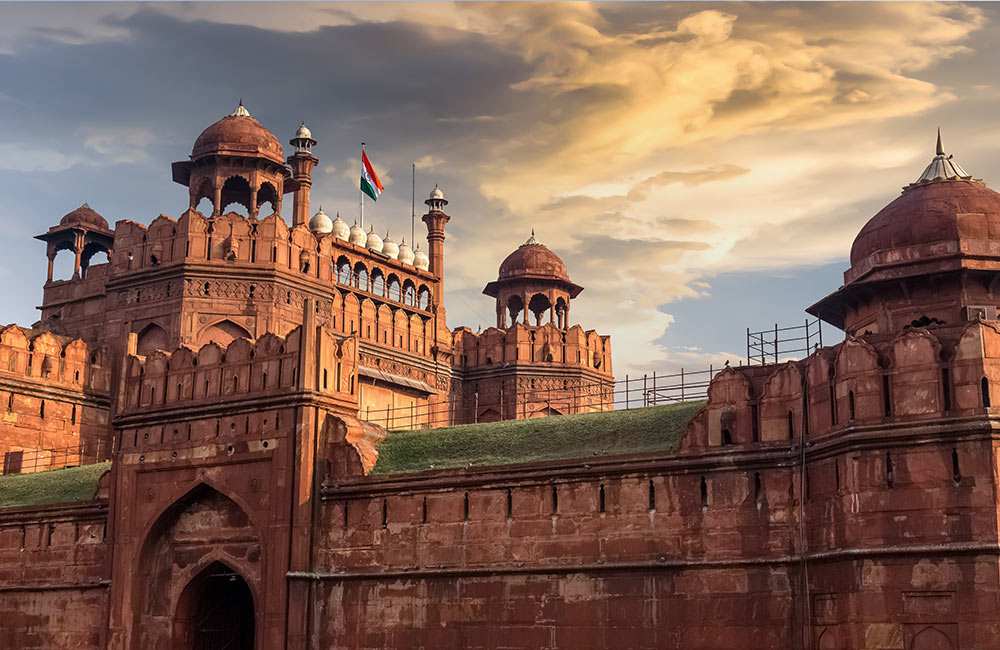
Red Fort (Lal Qila): A Majestic Emblem of India’s Heritage
The Red Fort, or “Lal Qila” in Hindi, stands as a grand testament to India’s rich history and architectural brilliance. Located in the heart of Old Delhi, this imposing fortress has witnessed centuries of cultural, political, and historical transformations, making it an enduring symbol of the nation’s heritage.
Historical Marvel:
Built during the reign of Emperor Shah Jahan, the Red Fort was completed in 1648 and served as the main residence for the Mughal emperors for nearly 200 years. Its construction marked the shift of the Mughal capital from Agra to Delhi and is a striking example of Mughal architecture.
Architectural Splendor:
The Red Fort is a masterpiece of red sandstone, displaying a fusion of Persian, Timurid, and Indian architectural styles. The fort’s intricate details, including delicate carvings, arches, and ornate domes, showcase the artistic brilliance of the craftsmen of that era. The fort’s Lahori and Delhi Gates serve as awe-inspiring entry points, each adorned with stunning motifs and calligraphy.
Symbol of Independence:
The Red Fort gained even greater significance in modern Indian history. It was the site where Jawaharlal Nehru, the first Prime Minister of independent India, hoisted the national flag on August 15, 1947, marking the country’s independence from British rule. The tradition continues today with the Prime Minister unfurling the tricolor on the ramparts of the fort during India’s Independence Day celebrations.
Intricate Layout:
The Red Fort is not just a single structure but a complex of palaces, pavilions, and gardens within its massive walls. The Diwan-i-Aam (Hall of Public Audience) and Diwan-i-Khas (Hall of Private Audience) are particularly notable for their architectural grandeur. The fort also houses the Mumtaz Mahal, Rang Mahal, and Khas Mahal, each with its own unique charm and historical significance.
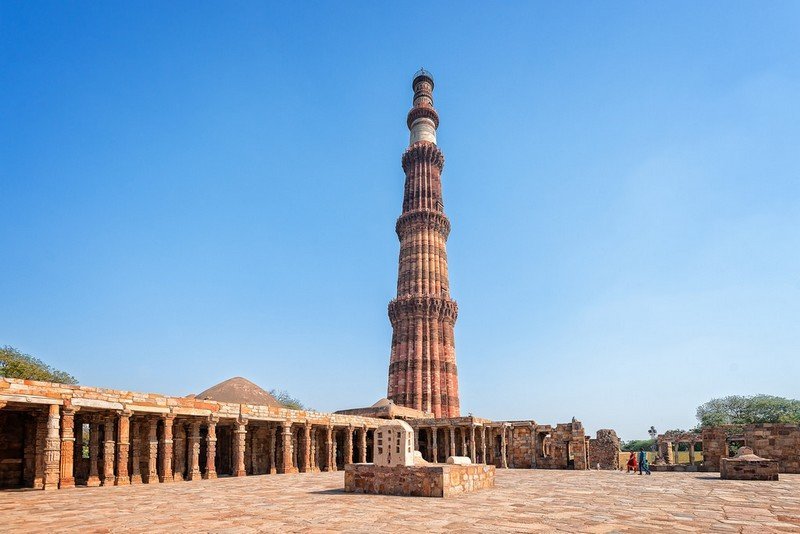
Qutub Minar: Standing Tall in Time as Delhi’s Ancient Marvel
Qutub Minar, an architectural masterpiece and a UNESCO World Heritage Site, graces the skyline of Delhi, India, with its towering presence. This iconic monument is a testament to the rich history and cultural amalgamation that defines India. Let’s delve into the history and significance of this awe-inspiring structure.
Historical Origins:
Commissioned by Qutub-ud-din Aibak, the first ruler of the Delhi Sultanate, in 1192, Qutub Minar stands as a symbol of triumph and power. Its construction continued under subsequent rulers, including Iltutmish and Firoz Shah Tughlaq, resulting in a structure that blends various architectural styles, notably Persian and Indian.
Architectural Marvel:
Qutub Minar is a five-tiered, tapering tower that reaches a height of 73 meters, making it one of the tallest brick minarets in the world. The first three tiers are made of red sandstone, while the upper two are constructed with marble and sandstone. The intricate carvings and verses from the Quran that adorn the structure reflect the craftsmanship of the medieval period.
The Quwwat-ul-Islam Mosque:
Adjacent to the minar stands the Quwwat-ul-Islam Mosque, the first mosque built in Delhi after the Islamic conquest. The mosque incorporates elements from Hindu and Jain temples, such as pillars and sculptures, showcasing the assimilation of different cultures during that era.
Iron Pillar:
In the courtyard of the mosque, a notable curiosity exists—the Iron Pillar of Delhi. This iron column, dating back to the 4th century, remarkably exhibits corrosion resistance. The inscriptions on the pillar suggest it was erected in honor of Lord Vishnu.
Historical Significance:
Qutub Minar has witnessed centuries of history, surviving the rise and fall of empires. Its original purpose was to serve as a muezzin’s tower for the call to prayer. Over time, it became a symbol of the might and grandeur of the ruling dynasties.
Tourist Attraction:
Today, Qutub Minar attracts millions of visitors annually. Tourists and history enthusiasts explore the complex, marveling at the minaret, the mosque, and the intricate details that tell the tales of bygone eras. The complex’s well-maintained greenery provides a serene backdrop to this architectural gem.
Preservation Efforts:
While Qutub Minar has withstood the test of time, preservation efforts are crucial to maintaining its structural integrity. Conservation measures are ongoing to protect this heritage site from environmental factors and the impact of increased footfall.
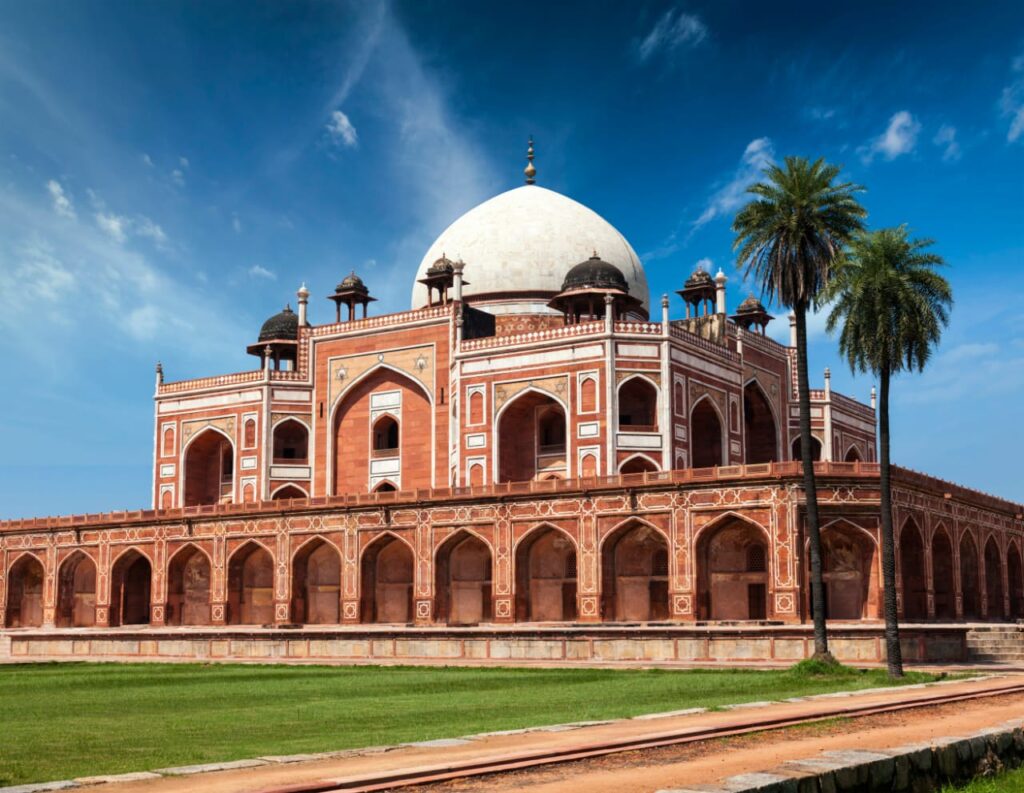
Humayun’s Tomb: A Majestic Blend of Heritage and Architecture
Nestled in the heart of Delhi, Humayun’s Tomb stands as a splendid testimony to Mughal architecture and the grandeur of the past. Commissioned by Hamida Banu Begum, the widow of the second Mughal emperor, Humayun, this mausoleum is a reflection of the era’s artistic finesse and cultural synthesis.
Historical Origins:
Built in the mid-16th century, Humayun’s Tomb is the tomb of the Mughal Emperor Humayun. It was commissioned by his widow, Empress Hamida Banu Begum, and completed in 1572. The tomb’s construction marked a significant departure from earlier architectural styles, setting the stage for the iconic Mughal architecture that reached its zenith with the Taj Mahal.
Architectural Splendor:
Designed by the Persian architect Mirak Mirza Ghiyas, the tomb complex is a captivating blend of Persian and Indian architectural styles. The central tomb is a massive structure, topped with a bulbous dome that exemplifies Persian influence. The garden, divided into four quadrants by water channels, reflects the charbagh (four gardens) style, a Persian concept integrated into Islamic gardens.
Charbagh Garden Layout:
The meticulously planned charbagh layout symbolizes the paradise garden in Islamic tradition. Walking through the garden, visitors encounter pathways, water channels, and lush greenery, creating a serene and harmonious atmosphere. The tomb stands at the center, providing a focal point amid the symmetrical arrangement.
Influence on Taj Mahal:
Humayun’s Tomb served as a precursor to the Taj Mahal, influencing its design and layout. The use of white marble, intricate carvings, and the placement of the mausoleum in the center of a charbagh garden are elements that were later perfected in the construction of the Taj Mahal.
Tombs and Structures:
The main tomb houses the cenotaph of Emperor Humayun, while his actual grave lies in a chamber below. Surrounding the central tomb are smaller chambers containing the graves of other members of the Mughal royal family. The tomb complex also includes the Barber’s Tomb, Isa Khan’s Tomb, and the Nila Gumbad.
Restoration and Recognition:
In recent years, significant restoration efforts have been undertaken to preserve Humayun’s Tomb and its surrounding structures. The meticulous conservation work has garnered international acclaim, and the site was designated a UNESCO World Heritage Site in 1993.
Tourist Attraction:
Today, Humayun’s Tomb stands as a major tourist attraction in Delhi, drawing history enthusiasts, architects, and admirers of cultural heritage. The site’s timeless beauty, coupled with its historical significance, makes it a must-visit destination for those seeking a glimpse into India’s imperial past.
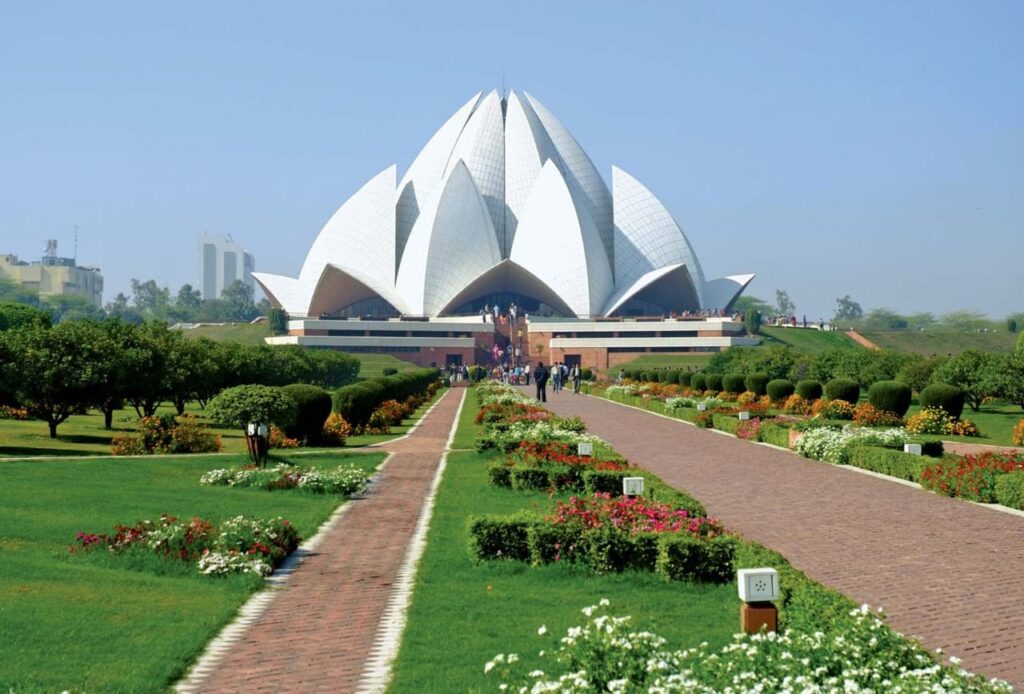
Lotus Temple: A Symbol of Harmony and Architectural Elegance
Nestled in the heart of New Delhi, the Lotus Temple stands as a remarkable testament to both architectural brilliance and the spirit of unity. Known for its distinctive lotus-shaped design and open-door policy, this Bahá’í House of Worship has become a symbol of peace, welcoming people of all faiths to its serene surroundings.
Architectural Marvel:
Designed by Iranian architect Fariborz Sahba, the Lotus Temple was completed in 1986. Its unique lotus-inspired structure is composed of 27 free-standing marble-clad “petals” arranged in clusters of three to form nine sides. The pristine white marble gives the temple a tranquil and ethereal appearance, further accentuated by its reflection in the surrounding pools.
Bahá’í Faith and Principles:
The Lotus Temple is one of the seven Bahá’í Houses of Worship around the world. The Bahá’í Faith, founded by Bahá’u’lláh in the 19th century, emphasizes the oneness of humanity, the unity of all religions, and the harmony of science and religion. The Lotus Temple embodies these principles by providing a space where people of all backgrounds can come together in prayer and meditation.
Open to All:
One of the most distinctive features of the Lotus Temple is its openness to people of all religions and beliefs. Visitors are welcome to enter the temple, irrespective of their faith, to pray, meditate, or simply find solace in its serene ambiance. This inclusivity reinforces the temple’s role as a symbol of unity in diversity.
Gardens and Surroundings:
Surrounded by lush green gardens and nine reflective pools, the Lotus Temple provides a tranquil oasis amidst the bustling city. The carefully landscaped grounds complement the temple’s aesthetic and offer a peaceful retreat for contemplation.
Environmental Considerations:
The Lotus Temple incorporates several environmentally sustainable features. Its design allows for natural lighting, reducing the need for artificial illumination during the day. The temple also utilizes rainwater harvesting methods to conserve water, aligning with the Bahá’í principles of environmental stewardship.
Recognition and Awards:
The Lotus Temple has received acclaim for its architectural excellence and contribution to promoting understanding and tolerance among diverse communities. It has been honored with numerous awards, recognizing its unique design and its role as a symbol of peace and unity.
Tourist Attraction and Spiritual Haven:
The Lotus Temple has become a popular tourist attraction, drawing visitors from around the world who are captivated by its architectural beauty and the message of inclusivity it represents. Beyond its tourist appeal, the temple serves as a spiritual haven for those seeking moments of reflection and connection.
In conclusion, the Lotus Temple is more than an architectural marvel; it is a living embodiment of the principles of unity, diversity, and harmony. As it continues to attract people from various walks of life, the Lotus Temple stands as a radiant symbol of peace and understanding in a world that often seeks common ground amid its differences
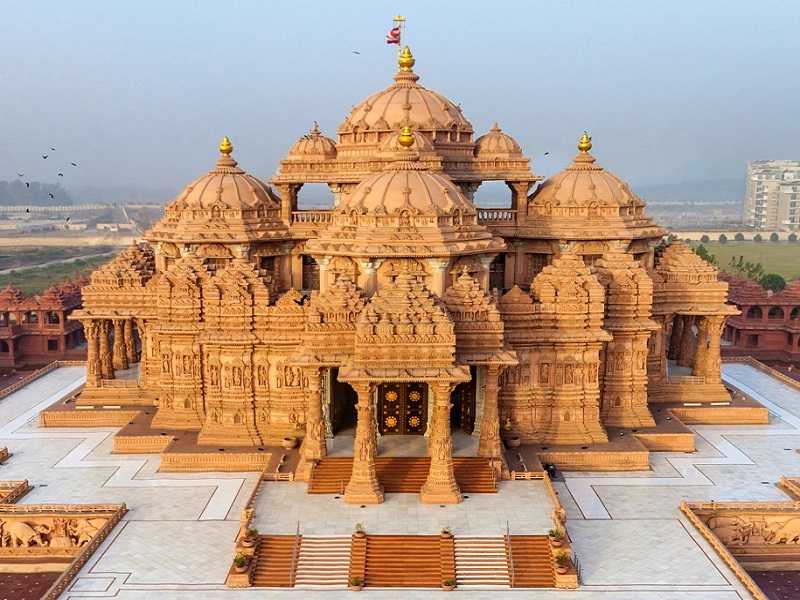
Akshardham Mandir
In the heart of Delhi, the Akshardham Mandir stands as a majestic testament to India’s rich cultural heritage, spiritual traditions, and architectural prowess. This modern marvel, dedicated to Bhagwan Swaminarayan, invites visitors to embark on a journey through time, exploring the intricacies of Indian art, devotion, and history.
Architectural Grandeur:
Akshardham Mandir, inaugurated in 2005, is a masterpiece of architecture. The main mandir, crafted from intricately carved pink sandstone and white marble, exemplifies the age-old craftsmanship of Indian artisans. The detailed carvings, depicting deities, flora, fauna, and scenes from Hindu scriptures, create a mesmerizing visual spectacle.
The Sahaj Anand Water Show:
The Akshardham complex offers more than just architectural brilliance. The Sahaj Anand Water Show narrates a poignant episode from the life of Bhagwan Swaminarayan, delivering a powerful message of love, forgiveness, and eternal values. The show’s interplay of water, light, and sound captivates audiences, leaving a lasting impression.
Yagnapurush Kund:
At the heart of the Akshardham complex lies the Yagnapurush Kund, the largest stepwell in the world. Adorned with 108 gaumukhs (cow heads) that spout water, this architectural marvel symbolizes a sacred water ceremony. Visitors can witness the spectacular musical fountain show, showcasing the harmonious blend of tradition and technology.
Abhishek Mandap:
The Akshardham Mandir offers devotees and visitors the opportunity to participate in the Abhishek Mandap, a ritualistic bathing ceremony of the deities. This immersive experience allows individuals to engage in the spiritual traditions of the Swaminarayan Akshardham philosophy.
Cultural Exhibitions:
The Akshardham complex houses the Yogi Hraday Kamal, a lotus-shaped structure that serves as a venue for exhibitions. These exhibitions delve into India’s ancient wisdom, values, and contributions to science, art, and spirituality. The exhibitions are a journey through time, enlightening visitors about the cultural tapestry that defines India.
Gardens and Landscapes:
The Akshardham complex is surrounded by meticulously landscaped gardens and water features. The lush greenery, symbolic sculptures, and serene atmosphere create a tranquil setting for contemplation and relaxation.
Spiritual Significance:
Beyond its architectural splendor and cultural exhibitions, Akshardham Mandir holds immense spiritual significance for followers of the Swaminarayan Akshardham tradition. The temple reflects the philosophy of Bhagwan Swaminarayan, emphasizing devotion, humility, and the pursuit of spiritual enlightenment.
Visitor Experience:
Akshardham Mandir attracts millions of visitors annually, providing them with a holistic experience that encompasses spirituality, art, and culture. The temple’s emphasis on inclusivity and universal values makes it a destination that transcends religious boundaries.
In conclusion, Akshardham Mandir is not just a temple; it is a living testament to India’s cultural richness and spiritual heritage. As visitors explore its grand architecture, partake in cultural exhibitions, and engage in spiritual practices, they embark on a journey that transcends time, connecting with the enduring traditions that shape India’s identity.
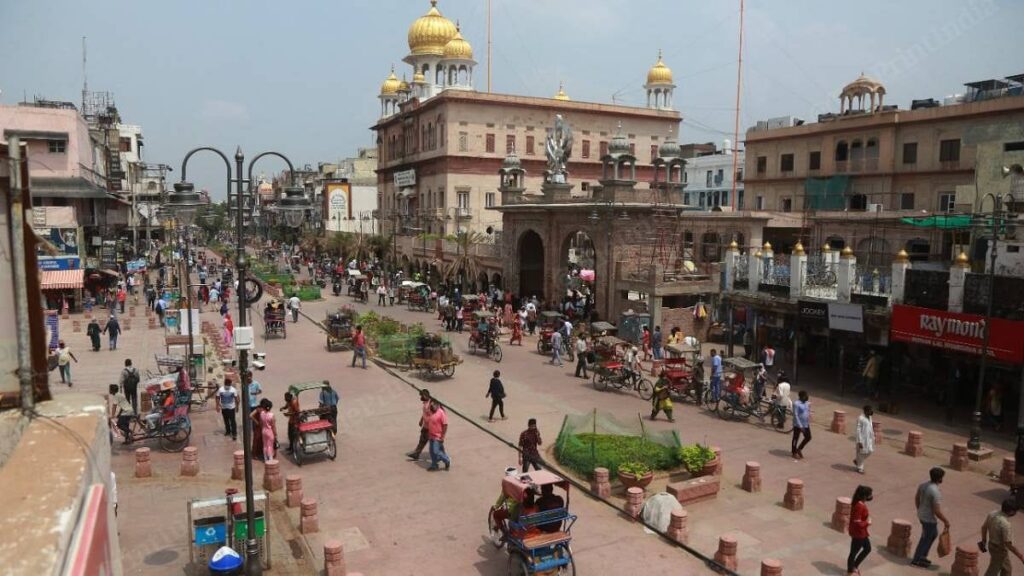
Chandni Chowk:
Nestled in the heart of Old Delhi, Chandni Chowk stands as a vibrant and chaotic testament to centuries of history, commerce, and cultural diversity. This bustling market area, one of the oldest and busiest in Delhi, carries the imprints of the Mughal era and has evolved into a kaleidoscope of experiences for locals and visitors alike.
Historical Roots:
Chandni Chowk, translating to “Moonlight Square,” was laid out by Shah Jahan in the 17th century as part of his vision for the capital city, Shahjahanabad. The grand avenue was adorned with a canal running through its center, reflecting moonlight—an enchanting sight that inspired its name.
Architectural Marvels:
As one navigates through Chandni Chowk, the architectural remnants of the Mughal era come to life. The Red Fort, a UNESCO World Heritage Site, stands at one end, while the iconic Jama Masjid, one of the largest mosques in India, looms large at the other. The narrow lanes are dotted with havelis, old mansions that once housed the nobility.
Commerce Hub:
Chandni Chowk has been a thriving commercial center for centuries. The market is a labyrinth of narrow lanes and alleys, each specializing in specific goods. From traditional Indian attire and jewelry in Dariba Kalan to spices and dried fruits in Khari Baoli, the market offers a diverse array of products, attracting shoppers from far and wide.
Street Food Paradise:
No visit to Chandni Chowk is complete without indulging in its delectable street food. Paranthe Wali Gali, renowned for its stuffed flatbreads, has been serving flavorsome paranthas since the 19th century. The area is also a haven for chaat lovers, offering a tantalizing array of flavors and textures.
Kinari Bazaar and Wedding Shopping:
Chandni Chowk is a hotspot for wedding shopping, with Kinari Bazaar being the go-to destination for bridal trousseaus and traditional wedding accessories. The bustling market caters to the vibrant and colorful tastes of Indian weddings, making it a beehive of activity during the wedding season.
Cultural Diversity:
Chandni Chowk is a melting pot of cultures, religions, and communities. Temples, churches, and gurdwaras coexist harmoniously, reflecting the city’s diverse religious fabric. The Gurdwara Sis Ganj Sahib, a significant Sikh shrine, holds historical importance, marking the site where Guru Tegh Bahadur was executed.
Preservation Challenges:
While Chandni Chowk pulsates with life, the area faces challenges related to congestion, pollution, and aging infrastructure. Efforts are ongoing to revitalize and preserve the historical charm of this iconic market while addressing modern urban challenges.
Tourist Attraction and Local Hangout:
Chandni Chowk is not just a market; it’s an experience. Tourists and locals alike throng its lanes to witness the amalgamation of history and commerce, to savor its culinary delights, and to soak in the vibrant energy that defines this historic quarter.
In conclusion, Chandni Chowk stands as a living canvas that captures the essence of Delhi’s rich history, its commercial vibrancy, and the cultural diversity that makes the city truly unique. Navigating through its lanes is not just a shopping spree; it’s a journey through time, an immersion into the soul of Delhi.

Connaught Place: The Heartbeat of New Delhi’s
Connaught Place, often referred to as CP, stands as a distinctive symbol of New Delhi’s urban charm and colonial legacy. This bustling commercial and cultural hub, designed in the early 20th century by the British architect Robert Tor Russell, has evolved into a dynamic center for shopping, dining, and entertainment, attracting both locals and tourists alike.
Architectural Marvel:
Built in the shape of two concentric circles, Connaught Place is an architectural masterpiece. The white Georgian-style colonnades, reminiscent of British architecture, encircle inner and outer circles, creating an aesthetically pleasing environment. The circular design is not just functional but also symbolizes unity and inclusivity.
Commercial Hub:
Connaught Place is synonymous with retail therapy. The market is home to a plethora of shops, ranging from high-end boutiques and international brands to local vendors offering traditional Indian goods. The vibrant Janpath market, known for its bohemian flair, adds an eclectic touch to the shopping experience.
Gastronomic Delights:
The culinary landscape of Connaught Place is a gastronomic delight. From iconic eateries like Wenger’s and United Coffee House, which have stood the test of time, to trendy cafes and international cuisine, CP caters to diverse palates. The area is a haven for food enthusiasts seeking everything from street food to fine dining.
Cultural and Entertainment Hub:
Connaught Place is not just about commerce; it pulsates with cultural energy. The area hosts numerous cultural events, from live music performances to art exhibitions. The centrally located Central Park often sees impromptu gatherings and cultural celebrations, adding a touch of vibrancy to the urban landscape.
Historical Landmarks:
Within Connaught Place, historical landmarks abound. The Regal Building, an iconic cinema hall, has been a witness to the evolution of Indian cinema. The historical Kasturba Gandhi Marg, named after Mahatma Gandhi’s wife, adds a touch of historical significance to the area.
Connectivity and Accessibility:
Connaught Place’s strategic location in the heart of Delhi makes it easily accessible. The Rajiv Chowk metro station, one of the busiest in the city, is a major transportation hub that connects different parts of Delhi and its neighboring areas.
Nightlife and Social Scene:
As the sun sets, Connaught Place transforms into a vibrant nightlife destination. Pubs, bars, and lounges come alive, offering a diverse range of entertainment options. The nightlife scene caters to various tastes, from casual hangouts to upscale experiences.
Preservation and Modernization:
While Connaught Place retains its historical charm, efforts have been made to modernize its infrastructure. Renovation projects have aimed at preserving the colonial architecture while introducing contemporary amenities to enhance the overall experience for visitors.
In conclusion, Connaught Place is more than a commercial center; it’s a microcosm of New Delhi’s spirit. Its blend of history, commerce, and cultural vibrancy makes it a place where the past seamlessly intertwines with the present. Connaught Place isn’t just a destination; it’s an experience that encapsulates the dynamic essence of India’s capital city
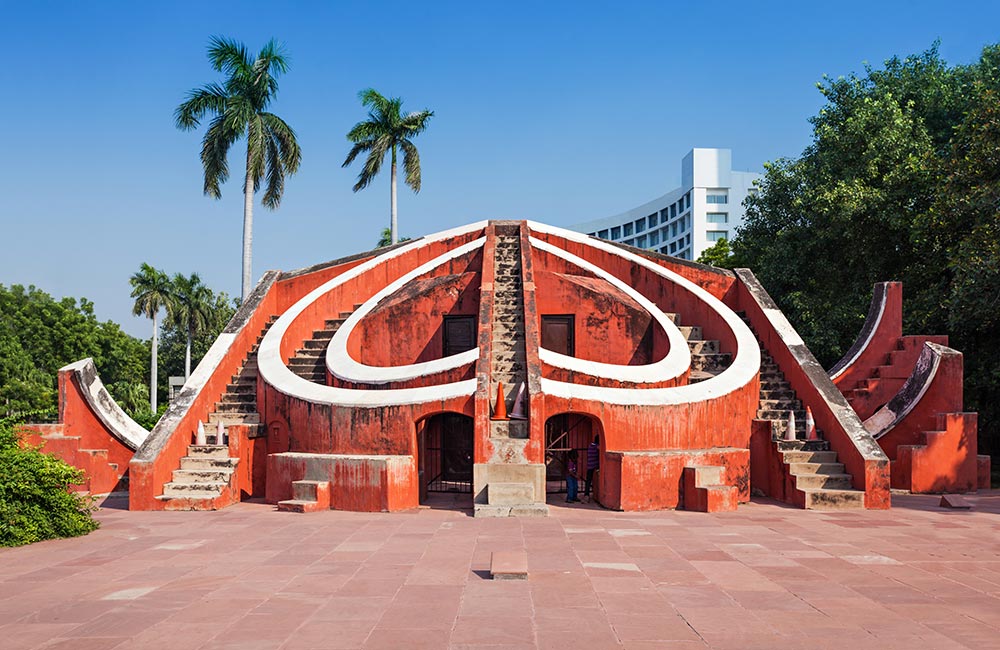
Jantar Mantar
Jantar Mantar, an architectural marvel nestled in the heart of Delhi, stands as a testament to India’s rich astronomical heritage. Constructed by Maharaja Jai Singh II of Jaipur in the early 18th century, this observatory is a collection of fascinating astronomical instruments that continue to captivate visitors with their precision and ingenuity.
Historical Significance:
Built in 1724, Jantar Mantar was one of five observatories erected by Maharaja Jai Singh II across North India. The purpose of these observatories was to gather accurate astronomical data, allowing for precise celestial calculations and the creation of reliable calendars. The term “Jantar Mantar” itself translates to “instrument and formula.”
Architectural Ingenuity:
Jantar Mantar’s architectural brilliance lies in its collection of 13 instruments, each designed for specific astronomical calculations. The instruments include the Samrat Yantra, the largest sundial in the world, and the Misra Yantra, a combination of five different instruments. The precision of these instruments, considering the era in which they were built, is a testament to the advanced scientific knowledge of the time.
Samrat Yantra:
The central attraction of Jantar Mantar is the Samrat Yantra, or Supreme Instrument. This massive sundial stands at a height of 27 meters and can be used to measure time with an accuracy of about two seconds. The shadow cast by the central triangular gnomon indicates the time, allowing astronomers to make precise measurements.
Astronomical Instruments:
Jantar Mantar houses various instruments designed for different astronomical purposes. The Ram Yantra measures the altitude and azimuth of celestial objects, while the Jai Prakash Yantra is used for measuring celestial altitudes and azimuths. Each instrument serves a specific purpose, showcasing the depth of understanding ancient astronomers had of the cosmos.
Symbol of Scientific Advancement:
Jantar Mantar reflects India’s historical contributions to the field of astronomy and mathematics. Maharaja Jai Singh II’s passion for astronomy and his collaboration with skilled architects and astronomers resulted in a scientific legacy that continues to be admired and studied.
Cultural and Tourist Attraction:
Jantar Mantar has transcended its original scientific purpose and become a cultural and tourist attraction. Visitors to Delhi are drawn to this site not only for its historical and scientific significance but also for its serene atmosphere. The open spaces and intriguing structures provide a unique blend of education and aesthetic appeal.
Preservation and Recognition:
Efforts have been made to preserve and maintain Jantar Mantar, ensuring that future generations can appreciate its historical and scientific importance. The site has been recognized as a UNESCO World Heritage Site, acknowledging its cultural and scientific value on a global scale.
In conclusion, Jantar Mantar stands as a celestial timepiece, connecting the present to India’s scientific past. Its intricate instruments tell a story of a bygone era when astronomers and mathematicians sought to unravel the mysteries of the cosmos. As visitors explore its grounds, they not only witness the architectural brilliance of Jantar Mantar but also gain a deeper appreciation for India’s enduring contributions to the sciences.

